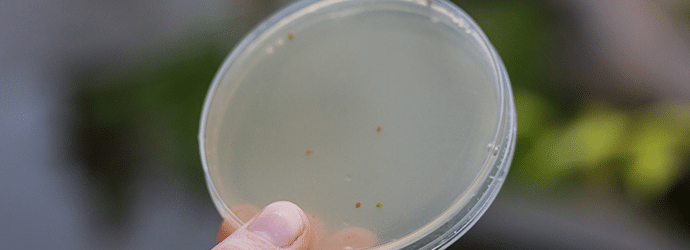While using human clinical samples in your research can provide robust and heterogeneous results applicable to larger portions of the population, working with these samples presents its own set of challenges.
Here are some tricks I have learned to help isolate and grow your cells of interest while eliminating stromal, blood, or other undesired contaminants.
1. Use (Lots of) Phosphate Buffered Saline Washes
Phosphate buffered saline (PBS) washes are a favorite of molecular biologists everywhere as they generally will not lyse or damage your cells while allowing for repeated washing of your clinical tissues.
How to use: If your desired tissue is covered in blood, wash with 30-40mL of cold PBS and gently shake. Remove large portions of remaining tissue and transfer to a new tube for each subsequent wash (each will increase yield of cells). After several washes, the larger tissue portion will be free of blood and stromal cells. Remember to save and centrifuge each PBS-filled tube that you used for washing if you wish to capture non-adherent tissues or cells.
Enjoying this article? Get hard-won lab wisdom like this delivered to your inbox 3x a week.

Join over 65,000 fellow researchers saving time, reducing stress, and seeing their experiments succeed. Unsubscribe anytime.
Next issue goes out tomorrow; don’t miss it.
Note: The use of PBS washes to isolate cells is most applicable to epithelial cells. Washes can also be used to gently remove stromal cells adhering to your tissue of interest.
2. Apply Isolated Cells to Coated Plates
Different cell types have diverse affinities for extracellular matrix proteins or similar compounds. You can quickly and easily coat plates and incubate with heterogeneous cell populations to isolate desired cells due to differential rates of adhesion.
How to use: For example, coat plates with collagen (for epithelial cells) or poly-L-lysine (for various cell types) to preferentially attach either desired or undesired cell populations. To remove the unbound undesirable cells, decant the culture medium.
Note: You’ll need to do some optimization to assess whether your cells of interest interact with the substrate (ex. some cell lines attach preferentially to poly-d-lysine as they produce proteases directed to poly-l-lysine).
3. Maintain Cells in Transwell Cultures
Maintaining cells in Transwell cultures – 24-well tissue culture grade plates containing culture medium and permeable cell supports coated with extracellular matrix or other components – is advantageous as you will not disturb your cells by directly adding medium or treatment on their surface. Further, cells cultured in this manner show native organization, polarity and distribution.
How to use: Coat inserts with desired substrate and allow it to dry before adding your cells. Once the adherent cells have been added, change the culture medium every 2 days by removing medium from the bottom compartment. If desired, you can also add treatments to your cells by adding 100mL or less of medium containing your desired compounds on top of your cells. As this is the only time medium is directly added to the cells, you limit the amount of perturbation they face.
4. Check the Purity of Your Cell Population With Cell-Type Specific Staining
You can use highly specific markers for epithelial cells (i.e. E-cadherin) and other cell types to examine cell purity. Once your populations of cells have been purified in the aforementioned manner, a small subset should be verified through common staining protocols. You can combine staining with microscopy or use chromogenic substrates that can be seen with the naked eye.
While this is certainly not an extensive list, I hope that these general tips will help those of you seeking to improve the clinical ramifications of your research work.
You made it to the end—nice work! If you’re the kind of scientist who likes figuring things out without wasting half a day on trial and error, you’ll love our newsletter. Get 3 quick reads a week, packed with hard-won lab wisdom. Join FREE here.







